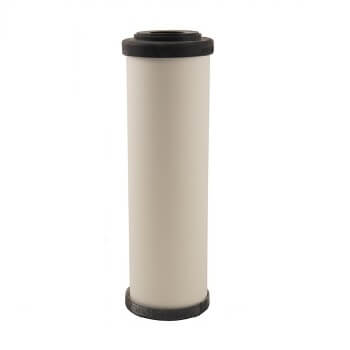
Ultimate Guide to Ceramic Water Filters
June 2, 2021 10:18 am Leave your thoughts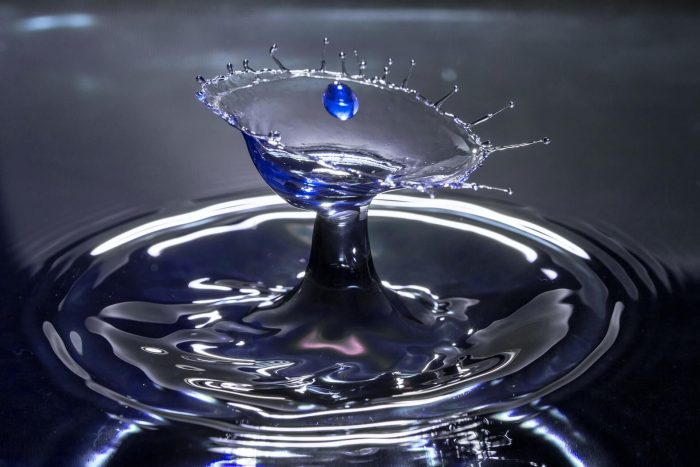
Water is an essential nutrient which humans need to survive. We need water to digest food, cool our bodies, lubricate our eyes, transport nutrients, eliminate toxins and to perform many other essential tasks.
Unfortunately, the water from our taps is often polluted with contaminants including chlorine, chloramines, trihalomethanes, agricultural chemicals, sediment, rust, and heavy metals.
If you drink tank water, you may be exposed to decaying organic matter, corroded roofing metal, and Cyst parasites like Cryptosporidium, Cyclospora, and Giardia.
The simplest way to improve the quality of the water you drink is by installing a water filter. In this guide, I’m going to share some information on ceramic filers, which offer extremely fine level filtration of contaminants at a reasonable price.
If you have any questions about ceramic water filters or ceramic filtration systems, contact Clarence Water Filters on 0266 468 565 or sales@clarencewaterfilters.com.au. We are one of the leading suppliers of ceramic water filters in Australia.
Products Featured In This Guide:
- UltraCarb 10″ x 2.5″ Doulton Ceramic Filter
- 1025 Streasyl 10” x2.5″ Doulton Ceramic Sediment Filter
- 1025 CeraMetix® 10″ x 2.5″ Fluoride Removal Ceramic Water Filter
- Doulton Ceramic Candle – Super Sterasyl 7″
- CeraMetix® 5″ Ceramic Candle Fluoride Reduction
- 1125 7″ Ceramic & Carbon In Line 0.9 Micron Filter push on Hose Fittings
Contents
What Are Ceramic Filters?
How Do Ceramic Filters Work?
Candle Type Ceramic Filters
Standard Filter Housing Canister type Ceramic Filters
Who Invented Ceramic Filters?
Ceramic Water Filter Pros and Cons
What Is the Best Ceramic Water Filter System?
Frequently Asked Questions
What Are Ceramic Water Filters?
Ceramic water filters use the fine pore size of ceramics to filter contaminants from water, including dirt, debris, bacteria, and cyst parasites.
Modern ceramic filters often include additional filtration media inside the walls of the ceramic shell for additional contaminant removal. This can include granular activated carbon, carbon blocks and proprietary blends of minerals.
How Do Ceramic Filters Water Work?
Ceramic filters work via mechanical filtration, where the filter acts like a sieve. As water flows through the ceramic filter surface, any particle that is larger than the pore size of the ceramic will be blocked.
Because ceramic pores are so fine, ceramic water filters can reduce or eliminate microscopic contaminants including sediment, protozoa, microbial cysts (giardia, cryptosporidium etc), and bacteria. However, ceramic filtration on its own is not effective against viruses.
Many ceramic filters will incorporate silver to destroy or incapacitate bacteria. The presence of silver can also prevent the growth of algae and mould in the filter itself.
It’s important to note that ceramic filters will not remove chemical contaminants. This is why manufacturers sometimes add a centre core of granular activated carbon (GAC) or a carbon block.
This makes the filter capable of reducing a range of organic and synthetic chemical contaminants including chlorine, chloramines, trihalomethanes, volatile organic compounds, PFAS, and polychlorinated biphenyls (PCBs).
Some ceramic water filters have proprietary blends of materials within their inner core. The Aquametix® and CeraMetix® filters, for example, use a special blend of carbon and minerals to achieve fluoride reduction (in addition to chlorine and chemical removal).
The most common styles of ceramic filter are:
Candle Type Ceramic Filters
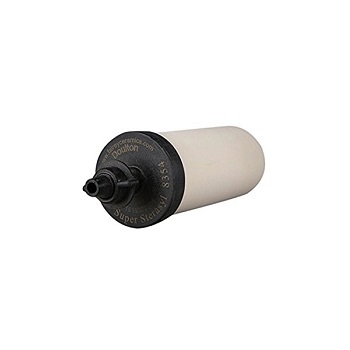
Mostly used in counter top Urns or bench top water wells.
Filter candles are ceramic filters moulded into the shape of a candle with a hollow centre core. Ceramic candles usually have a screw-in base, which allows it to be attached to an urn or canister housing.
Water flows from the outside of the candle to its interior. The small pore size of the ceramic surface will reduce the amount of sediment, protozoa, microbial cysts and bacteria which can pass through.
Once the water has reached the centre of the candle, it flows out through a hole in the base, passing into a receptacle or hose line.
Filter candles can be placed in plastic and metal receptacles, which make them a more sanitary option compared to ceramic urns. They can also be used in inline or canister systems.
Standard Filter Housing Canister type Ceramic Filters
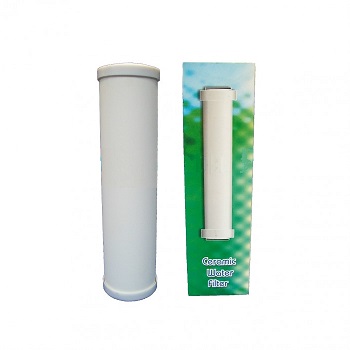
A canister ceramic filter is a cylindrical filter that is placed into a standard housing. It works on the same principle as a ceramic candle, with water being pushed from the exterior of the filter to a central core before exiting via the middle of the filter.
This type of filter can be installed in a normal benchtop or under bench filtration system. Most cannister filters are also larger in size, which provides more surface area for water to be processed, delivering faster flow rates.
Both candle and housing style ceramic filters have advantages over pot type ceramic filters including:
- Better protection
- Can fit more types of receptacles
- Useful for a variety of additional applications compared to other filter cartridges
- Multiple candles or filters can be used to achieve faster flow rates
Who Invented Ceramic Filters?
The technology behind modern ceramic filters was first developed by John Doulton in 1827. Doulton was interested in filtering contaminants from the Thames River, which was heavily polluted at the time.
In 1835, Doulton was He was commissioned by Queen Victoria in 1835 to create a product to filter water in the Royal household. He created a large stone cannister which uses gravity to filter water through a ceramic filter. It was a revolutionary product that quickly became popular in the UK. Doulton filters are still one of the most popular brands of ceramic filters today.
Modern ceramic filters are more sophisticated and will often combine ceramics with carbon, silver and other types of filtration media.
Ceramic Water Filter Pros and Cons

All water filtration products have a specific set of pros and cons. Ultimately, your personal preferences and water filtration requirements will determine if the pros outweigh the cons.
Ceramic Water Filter Pros
- Made from a natural medium
Ceramic is a natural non-toxic substance that is completely harmless to humans. You don’t have to worry about the filter malfunctioning and contaminating your water in unexpected ways. - Proven reduction of bacteria and protozoa in water
Ceramic filters have been shown to be extremely effective at dealing with these contaminants. The Doulton Ultracarb, for example, has been proven to provide Absolute filtration to 0.9 microns 99.99%, Cysts including live Cryptosporidium 99.999%, plus bacteria like E.Coli, Shigella, Salmonella, Klebsiella & Cholera 99.99% - Ultra-fine Filtration
Ceramic filters can achieve ultra-fine filtration. This is why they are so effective at removing cyst parasites and incapacitating bacteria. A filter like the Doulton Ultracarb, for example, has a filtration efficiency of >99.99% at 0.9 microns, >99.9% at 0.5 – 0.8 µm, and >98% at 0.2 – 0.5 µm. - Affordable
100% ceramic filters are extremely affordable. Even the composite ceramic filters that are silver infused or contain an additional inner core filtration media are reasonably priced, especially considering the capabilities of the filter. Given the long lifespan of ceramic filters you can obtain incredible value-for-money. - Candle Filters Available in 5”, 7” and large sizes
Ceramic candle filters are available in two main lengths. 5” candles are ideal for traveling or when you only have limited height between the top and bottom containers. While the 7” candles will give you a larger surface area on the candle which will allow a slightly higher flow rate and longer between cleaning intervals. - Versatile
One of the most useful benefits of ceramic filters is their versatility. For example, you could use ceramic filtration to make a gravity fed water filtration system using a couple of buckets (handy for camping or traveling) or you could use ceramic water filtration in multi-filter installations. They can be used in bench top systems, undersink systems, in urns, or as an inline filter. The possibilities are endless! - Removes CYST Parasites
The fine pores of ceramic filters have been proven to remove cyst parasites from water including giardia, cryptosporidium, and cyclospora cayetanensis. - Long Lifespan
A well-maintained ceramic filter can last for 12 months. All you need to do is regularly remove the filter from its housing and give it a clean. Eventually, you will wear down the ceramic layer, at which time it needs to be replaced.
It’s important to note that most ceramic filters also contain activated carbon. This means they need to be be replaced more frequently than the ceramic-only filters because the carbon is likely to reach full capacity within 6-12 months (depending on your water quality). - Simplicity of use
Ceramic filters are simple to install and maintain. No electronics or unusual fittings are involved. It is easy to tell when your filter needs to be cleaned or replaced. - Easy to find replacements
Ceramic filters are very popular, so it’s simple to find replacements when you need one. - Compatibility
Ceramic water filters are usually sold as screw in candles, standard 10″ x 2.5″ double open ended filters or 9″ x 2.5″ double open ended filters. They are standard sizes which are compatible with dozens of different urns and filter housings. You won’t get locked into a filter system with a strange filter head or proprietary system only available from a single manufacturer.
Ceramic Water Filter Cons
- Frequent Cleaning
The main downside of using a ceramic filter is that it can clog up quickly because it is so fine. This is particularly true if you are filtering water with high levels of sedimentation. If your water quality isn’t great, you may find yourself cleaning your ceramic filter every few weeks. This is the reason why we usually recommend the use of a sediment filter before a ceramic filter in under-bench and benchtop filter systems. If you are using a urn type ceramic filter, you will also need to clean the cistern frequently. Filters and receptacles must be cleaned regularly, especially after filtering turbid water. - No Chlorine or Chemical Reduction (on 100% ceramic filters)
100% ceramic filtration will not remove chlorine or its by-products (chloramine and trihalomethanes), or other chemicals. To reduce chemical contaminants, you will need to use a ceramic filter with an inner core containing activated carbon and/or KDF. - Not Effective Against Viruses
Ceramic filters will not kill or disable viral contaminants. To eradicate viruses, water must be boiled, chemically treated, or processed using a UV system. - Variable Quality Control
The quality of ceramic filters can vary dramatically between different manufacturers. Cheaper products may have a thin ceramic outer layer which does not the same fineness as a quality product or is easily damaged. - Fragile
Ceramic filters are quite delicate and prone to cracking. If you drop a ceramic filter or hit it against a housing, it is very likely to chip or fracture. This can be a very expensive mistake! - Must Be Handled Hygienically
If you touch the ceramic filter, any contaminants on your skin can be transferred to its surface. This can block the filter’s fine pores, making it less effective. If your hands are very dirty it can even cause the filter to become a breeding ground for viral or bacterial contaminants. - A Slow Flow Rate
The fine pore size of ceramic filters means that water moves very slowly through the filter. A traditional gravity fed pot ceramic filter can have a flow rate as low as 1 litre per hour. Filter housing systems that are under mains pressure are much faster, but still slow compared to other forms of filtration. - More pressure required to push water through the filter
The small pore size means that a decent amount of water pressure is required to push water through the filter. This can be challenging if you are using a very small water pump or running a gravity fed water filtration setup.
What Is the Best Ceramic Water Filter System?
The best ceramic water filter will depend on several factors including your filtration requirements, budget, available space, and the quality of your water. Here are the five most popular ceramic filters in Australia from our product catalogue:
#1 – UltraCarb 10″ x 2″ Housing Type Doulton Ceramic Filter
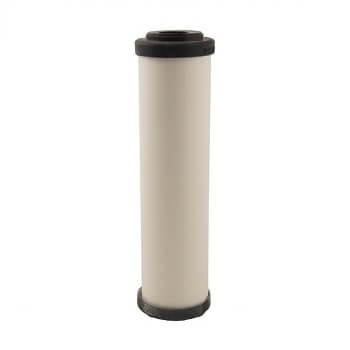
The UltraCarb water filter is a 10″ x 2″ canister filter made by Doulton. This UK-made filter is one of the finest three stage ceramic water filters available in Australia. It is capable of reducing a wide range of contaminants to provide delicious, clean tasting water.
The first stage is the outer ceramic shell, which has a 0.2 micron rating. This provides exceptional protection against bacteria, sediment, protozoa, and cyst parasites.
Inside the ceramic shell is stage 2 — a 1 micron carbon block filter, which will reduce chemicals, chlorine, chloramines, bad taste and odours.
The third stage is an Ion exchange Resin. This reduces the levels of heavy metals in your water, providing you with complete protection.
The UltraCarb will provide absolute filtration to 0.9 microns, which will remove or incapacitate:
- 99%, Cysts including live Cryptosporidium 99.999%
- Lead 98.3%
- Chlorine 95% at 2PPM
- Bacteria including E.Coli, Shigella, Salmonella, Klebsiella & Cholera 99.99%
The UltraCarb 10” has a Flow rate 1.9 Lpm and capacity of approximately 12 months depending on water quality. Measuring 248mm by 72mm, it will suit standard 10″ housings like our American made QMP housings. Other part numbers include 21419, CE941. Learn more about the Ultracarb 10″.
The UltraCarb is also available in a 9” Non Standard size. The 9” UltraCarb measures Dimensions are 228mm by 72mm. Learn more about the UltraCarb 9”.
#2 – 1025 Streasyl 10” Doulton Ceramic Sediment Filter

The 1025 Doulton Imperial Sterasyl Ceramic sediment filter is designed to fit standard 10” filter housing. It is a very fine ceramic filter with a 0.9 micron rating (absolute).
It can effectively reduce very fine sediment particles including dirt, sand, rust, algae, and minerals. The 1025 Sterasyl is also cyst rated, so can be used to protect your water supply from cyst parasites including cryptosporidium and giardia.
This fine pores on this filter mean it can also incapacitate bacteria up to 99.99% with a flow rate of 6.75 LPM. This includes E.Coli, Shigella, Salmonella, Klebsiella & Cholera.
Like the other ceramic filters listed here, the surface can be scrubbed as the pores fill up, restoring its flow rate.
The 10” filter’s dimensions are 248mm x 72mm. Learn more about the 10″ Doulton Sterasyl Ceramic Filter.
There is also a 9” non-standard version of the Doulton Ceramic available, which measures Dimension are 228mm x 72mm. Learn more about the 9″ Doulton Sterasyl Ceramic Filter.
#3 – 1025 CeraMetix® Fluoride Removal Ceramic Water Filter
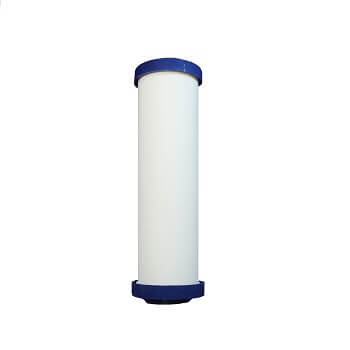
The 1025 CeraMetix® is a technologically sophisticated filter which can greatly reduce chlorine, chloramines, trihalomethanes, sediment, bacteria, fluoride, heavy metals, cyst parasites, and other contaminants.
It has an ultra fine micro porous outer shell surrounding a central core made from AquaMetix® core block. This combination of mechanical filtration and physical absorption is extremely effective.
It uses high-quality materials including coconut shell based carbon and other absorbent materials. They use an innovative moulding manufacturing process to combine these materials into a solid block that delivers a uniform pore size, consistent performance, and outstanding contaminant removal rates.
The AquaMetix® core will improve taste and odour as well as reducing chlorine, chloramine, volatile organic compounds, MTBE, lead, mercury, asbestos, arsenic and fluoride.
The ceramic shell is useful for removing or incapacitating suspended solids, pathogenic bacteria and cysts. This filter has been tested in accordance with ANSI/NSF protocols for cyst, turbidity, particulates, lead, heavy metals, pharmaceutical compounds, chloramines and chlorine reduction (Class 1).
The 10” model measures 248mm and fits standard 10 inch housings. It has 5,455 litres capacity for chlorine, 4,546 for lead reduction and 1,700 litres for Fluoride. Read more about the 1025 CeraMetix 10″ Fluoride Removal Ceramic Water Filter.
The 9” model measures 228mm in length and is designed for non standard 9″ housings. It has 5,455 litres capacity for chlorine, 4,546 for lead reduction and 1,700 litres for Fluoride. Read more about the 925 CeraMetix 9″ Fluoride Removal Ceramic Water Filter.
#4 – Doulton Candle Super Sterasyl
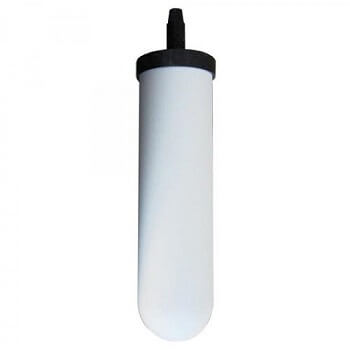
The 7″ Doulton Super Sterasyl Ceramic water filter candle is a 3 stage filter that combines mechanical and absorption filtration techniques. It can dramatically reduce sediment, rust, algae, chemicals, bad taste & odours, bacteria and other common contaminants.
Stage 1 of the filter is the ceramic outer layer, which is capable of filtering water to 0.9 micron absolute. This dramatically reduces the level of parasitic cysts, bacteria, and sediment particles in your water.
Stage 2 is a layer of silver impregnated ceramic media. This performs an anti-bacterial function, inhibiting microbiological growth in the candle.
Stage 3 is a granular activated core (GAC) which reduces chlorine, chloramines, pesticides, volatile organic compounds, organic particles. This stage also improves the taste and odour of your water.
It is a UK made filter built to a very high standard. Recommended life of 6 months or 2000 litres depending on water quality.
It is compatible with most urn type bench top water filters including Waterco, Stoneware, Aquaramic, Vitali, Stefani, Terra Cotta, Southern Cross, Pozzani, Altantis, and Australis.
Dimensions are 177mm long (excluding the thread) x 50mm diameter. Thread Dimensions are 27mm long x 12mm wide. Read more.
#5 – CeraMetix® Candle Super Ceramic Fluoride Reduction
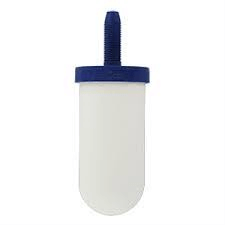
The CeraMetix™ is one of the most technologically advanced ceramic filters ever designed. It uses a combination of sophisticated technologies to reduce a range of impurities including fluoride. It combines mechanical filtration and physical adsorption processes to deliver an extremely high level of filtration.
The outer shell is made from silver impregnated ceramic. It has an extremely fine pore size which dramatically reduces bacterial pathogens, suspended solids, protozoan contaminants, and cyst parasites. The presence of silver offers an additional bacteriostatic function, keeping bacteria from growing in the filter’s housing.
The proprietary AquaMetix® core improves taste and odour as well as reducing fluoride, chlorine, chloramine, volatile organic compounds, MTBE, lead, mercury, asbestos, arsenic and pharmaceutical compounds.
The CeraMetix® elements have been tested in accordance with ANSI/NSF protocols for cyst, turbidity, particulates, pharmaceutical compounds, chloramines, lead, heavy metals, and chlorine reduction (Class I).
It is an American made product and one of the best ceramic filters available in Australia.
Some of contaminants it can remove include:
- Pathogenic bacteria >99.9999% Cholera, Typhoid, Salmonella, Coli, Faecal Coliform
- 100% Cryptosporidium Parvum, Giardia Lamblia
- 100% to 0.5 micron absolute sediment removal
- Chloramines >99% ANSI/NSF Standard 42
- Chlorine >99% ANSI/NSF Standard 42
- Fluoride >97% All types—Fluoro silicic acid / hydro fluorosilicate, sodium fluorosilicate, and sodium fluoride
- Lead >99% ANSI/NSF Standard 53
- VOC’s >98% ANSI/NSF Standard 53
- THM’s >98% Reduction
- Metals >98% Aluminium, Iron, Mercury, Nickel & Zinc ANSI/NSF Standard 53
- Glyphosate >99.9%
- Pharmaceutical Compounds >95% ANSI/NSF Standard 401 Acetaminophen, Progesterone, Ibuprofen, Naproxen Sodium
- Herbicides >99%
- Nitrates >92%
The CeraMetix® candle is available in 5” or 7” sizes.
The 7” CeraMetix® candle is 180mm long (excludes the thread), 50mm diameter. Thread Dimensions 30mm long, 12mm wide, rubber seal and lock nut included. It has a recommended filter service life of between 6 to 12 months or 3785 litres. Read more.
The 5” CeraMetix® candle is 110mm long (excludes the thread), 50mm diameter. Thread Dimensions 30mm long, 12mm wide, rubber seal and lock nut included. Recommended filter service life of between 6 to 12 months or 2275 litres Read more.
#6 – 1125 7″ Ceramic & Carbon In Line 0.9 Micron Filter push on Hose Fittings
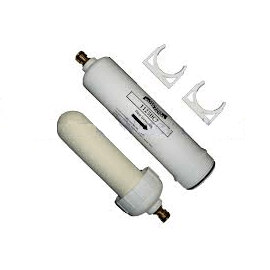
1125 In Line cleanable 7″ ceramic water filter is a portable ceramic filtration solution popular with the owners of caravans, RVs, motor homes, and vans. It comes with posh on hose (POH) fittings, letting you quickly filter water from a water tank, bore, or any other source.
The reusable housing has a 7″ Doulton ceramic water filter candle with a rating of 0.9 absolute. This filter has a granular activated carbon, making it capable of reducing sediment, rust, algae, chemicals, bad taste, odours and bacteria.
It is a cyst rated filter, which means it is capable of reducing cyst parasites including Cryptosporidium Parvum, and Giardia Lamblia.
Like the other filters mentioned here, it can be cleaned with a scouring pad whenever the flow rate declines. Flow rate is 1.9 litres per minute and service life is up to 12 months.
It measures 365mm (including the hose fittings) by 65mm. Mounting clips are available and it can be mounted vertically if required. The inlet of this filter is at the top and the outlet at the bottom. The filter can be replaced by unscrewing one end. Read more.
Frequently Asked Questions
- What Is The Best Ceramic Water Filter In Australia?
- Which Ceramic Filters Can Remove Fluoride?
- How Often Will I Need To Clean My Ceramic Filter?
- How Do You Clean A Ceramic Filter?
- Do Ceramic Water Filters Remove Viruses?
- What is a Ceramic Carbon Water Filter?
- How Long Do Ceramic Water Filters Last?
- Are Ceramic Water Filters Good?
- How Effective Are Ceramic Water Filters?
- What Is The Best Bench Top Ceramic Water Filter?
What Is The Best Ceramic Water Filter in Australia?
Best Ceramic Cartridge Filter
There two best options are the Ultracarb and the 1025 CeraMetix®.
The Ultracarb is a sophisticated water filter that combines a fine ceramic outer shell with carbon and ion exchange resin.
It will reduce a huge range of contaminants, including heavy metals, chlorine, chloramines, sediment, CYST parasites (giardia, cryptosporidium etc), pesticides, volatile organic compounds and much more. You can use it with under sink or benchtop housing.
The Ultracarb is available in two sizes: 10″ x 2.5″ and 9″ x 2.5″.
If you are concerned about fluoride, the best ceramic cartridge would be the 1025 CeraMetix®.
It reduces sediment, bacteria, chlorine, chloramines, volatile organic compounds, bad taste/odour, fluoride, CYST parasites (giardia, cryptosporidium etc), pesticides, and many other contaminants.
Best Ceramic Candles
If you are using a ceramic urn and mostly concerned about sediment, bacteria, and chemicals, the best option would be a Doulton Sterasyl. They are available in 5″ and 7″ sizes.
If you are also concerned about fluoride, then opt for the CeraMetix Candle Super Ceramic Fluoride Reduction Filter. Available in 5″ and 7″ sizes.
Which Ceramic Filters Can Remove Fluoride?
- 1025 Cerametix 10″ x 2.5″ (Cartridge Filter)
- Cerametix 5″ Candle, or Cerametix 7″ Candle (Candle Filters)
They contain a proprietary blend of Zeolite minerals which can absorb over 90% of fluoride from your water.
How Often Will I Need To Clean My Ceramic Filter?
If you are in an area with high levels of sediment and using a canister type setup, it is recommended that you place a sediment filter before your ceramic filter, to prevent it clogging up too quickly.
A 1 micron or 0.5 micron polyspun filter is ideal as it will soak up the vast majority of particulate matter before it can clog up the ceramic filter’s pores.
How Do You Clean A Ceramic Filter?
We’ve created a handy guide on how to clean ceramic filters. It is a relatively simple process that involves gently scrubbing the ceramic surface with a clean scouring pad.
Do Ceramic Water Filters Remove Viruses?
Viruses are microorganisms which can be up to 1,000 times smaller than bacteria. That is much smaller than the pores in ceramic water filters, which means you can not rely upon ceramic filtration alone to eliminate viruses.
Fortunately, chlorine is very effective at eradicating viruses, so you shouldn’t have anything to worry about if you are on town water.
If you are not on town water and are concerned about viruses, the best option is to install a Ultraviolet Sterilizer (UV System). UV Systems use intense ultraviolet light to kill 100% of the viral, bacterial, algal, and protozoan contaminants. Give us a call to learn more.
What is a Ceramic Carbon Water Filter?
How Long Do Ceramic Water Filters Last?
- The size of the filter
- The contents of the filter
- The quality of water you are filtering
- The amount of water you are filtering
Theoretically, the ceramic exterior of a ceramic filter can last for many years. However, the carbon and other media inside of the filter (which capture chemicals and/or fluoride) will reach full capacity well before then.
In most cases, a 10″ x 2.5″ ceramic water filter will last about a year. Ceramic candle water filters usually last about 6 months.
If you are using a lot of water or the water quality is particularly bad, you may experienced a reduced lifespan. The warning signs that the carbon in your ceramic filter has reached full capacity include a slower flow rate and the water’s taste/odour worsening.
Are Ceramic Water Filters Good?
Simple answer – yes they are very good!
They provide a very fine level of sediment filtration in addition to chemical filtration. Plus the fact they can remove bacteria makes them useful for situations where you don’t have access to treated water.
The only real downside of using a ceramic filter is that they can clog up quickly if you have high levels of sediment. If you are using a cartridge style filter, you can place a sediment filter before the ceramic one to protect it from excessive sediment.
How Effective Are Ceramic Water Filters?
In fact, the only other products which can remove bacteria are UV systems and Reverse Osmosis. Both of which are much more expensive and difficult to maintain.
What Is The Best Bench Top Ceramic Water Filter in Australia?
Many people choose to install a large urn with a ceramic filter. Unfortunately, there are several downsides to this option, including the huge amount of space it takes up and the fact you will need to manually fill it up with water. The candle filters inside of urns also have less surface area and less carbon content compared to cartridge type filters.
A better option is a benchtop canister system with a ceramic filter. It will take up less space, involve less maintenance (no constant refilling) and will deliver improved performance.
If you are living in a high sediment area, you could purchase a twin benchtop system with a sediment filter before the ceramic filter.
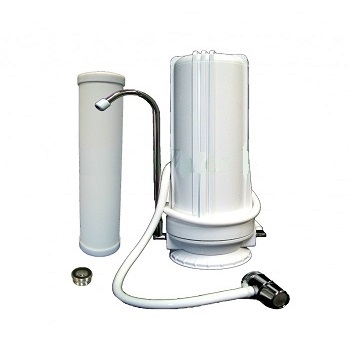
Wrapping Up
As you can see, ceramic filters are the perfect option if need a water filter with an extremely fine level of filtration. Whether you use a single ceramic water filter cartridge or a complete ceramic water filter system, you will obtain a great result.
If you have any questions about ceramic water filters, contact us today:
Clarence Water Filters Pty Ltd
Phone: 02 6646 8565
Email: sales@clarencewaterfilters.com.au
Tags: Buyers Guide, Buying Ceramic Filters, Ceramic, Ceramic Water Filters, CeramicsCategorised in: Buyer's Guides
This post was written by Paul
